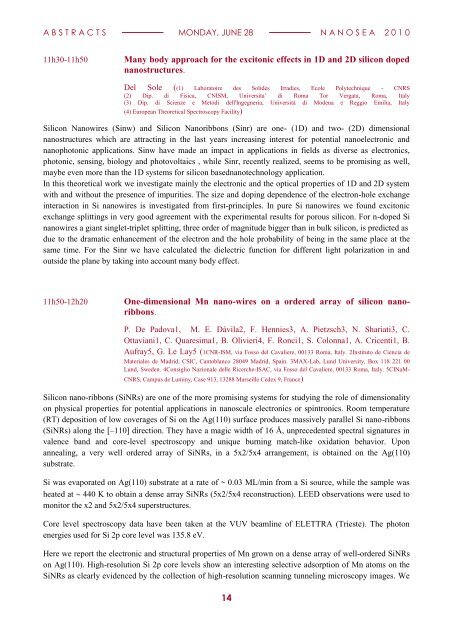book of abstracts - IM2NP
book of abstracts - IM2NP
book of abstracts - IM2NP
You also want an ePaper? Increase the reach of your titles
YUMPU automatically turns print PDFs into web optimized ePapers that Google loves.
A B S T R A C T S MONDAY, JUNE 28 N A N O S E A 2 0 1 0<br />
11h30-11h50<br />
Many body approach for the excitonic effects in 1D and 2D silicon doped<br />
nanostructures.<br />
Del Sole ((1) Laboratoire des Solides Irradies, Ecole Polytechnique - CNRS<br />
(2) Dip. di Fisica, CNISM, Universita‟ di Roma Tor Vergata, Roma, Italy<br />
(3) Dip. di Scienze e Metodi dell'Ingegneria, Università di Modena e Reggio Emilia, Italy<br />
(4) European Theoretical Spectroscopy Facility)<br />
Silicon Nanowires (Sinw) and Silicon Nanoribbons (Sinr) are one- (1D) and two- (2D) dimensional<br />
nanostructures which are attracting in the last years increasing interest for potential nanoelectronic and<br />
nanophotonic applications. Sinw have made an impact in applications in fields as diverse as electronics,<br />
photonic, sensing, biology and photovoltaics , while Sinr, recently realized, seems to be promising as well,<br />
maybe even more than the 1D systems for silicon basednanotechnology application.<br />
In this theoretical work we investigate mainly the electronic and the optical properties <strong>of</strong> 1D and 2D system<br />
with and without the presence <strong>of</strong> impurities. The size and doping dependence <strong>of</strong> the electron-hole exchange<br />
interaction in Si nanowires is investigated from first-principles. In pure Si nanowires we found excitonic<br />
exchange splittings in very good agreement with the experimental results for porous silicon. For n-doped Si<br />
nanowires a giant singlet-triplet splitting, three order <strong>of</strong> magnitude bigger than in bulk silicon, is predicted as<br />
due to the dramatic enhancement <strong>of</strong> the electron and the hole probability <strong>of</strong> being in the same place at the<br />
same time. For the Sinr we have calculated the dielectric function for different light polarization in and<br />
outside the plane by taking into account many body effect.<br />
11h50-12h20<br />
One-dimensional Mn nano-wires on a ordered array <strong>of</strong> silicon nanoribbons.<br />
P. De Padova1, M. E. Dávila2, F. Hennies3, A. Pietzsch3, N. Shariati3, C.<br />
Ottaviani1, C. Quaresima1, B. Olivieri4, F. Ronci1, S. Colonna1, A. Cricenti1, B.<br />
Aufray5, G. Le Lay5 (1CNR-ISM, via Fosso del Cavaliere, 00133 Roma, Italy. 2Instituto de Ciencia de<br />
Materiales de Madrid, CSIC, Cantoblanco 28049 Madrid, Spain. 3MAX-Lab, Lund University, Box 118 221 00<br />
Lund, Sweden. 4Consiglio Nazionale delle Ricerche-ISAC, via Fosso del Cavaliere, 00133 Roma, Italy. 5CINaM-<br />
CNRS, Campus de Luminy, Case 913, 13288 Marseille Cedex 9, France)<br />
Silicon nano-ribbons (SiNRs) are one <strong>of</strong> the more promising systems for studying the role <strong>of</strong> dimensionality<br />
on physical properties for potential applications in nanoscale electronics or spintronics. Room temperature<br />
(RT) deposition <strong>of</strong> low coverages <strong>of</strong> Si on the Ag(110) surface produces massively parallel Si nano-ribbons<br />
(SiNRs) along the [–110] direction. They have a magic width <strong>of</strong> 16 Å, unprecedented spectral signatures in<br />
valence band and core-level spectroscopy and unique burning match-like oxidation behavior. Upon<br />
annealing, a very well ordered array <strong>of</strong> SiNRs, in a 5x2/5x4 arrangement, is obtained on the Ag(110)<br />
substrate.<br />
Si was evaporated on Ag(110) substrate at a rate <strong>of</strong> ~ 0.03 ML/min from a Si source, while the sample was<br />
heated at 440 K to obtain a dense array SiNRs (5x2/5x4 reconstruction). LEED observations were used to<br />
monitor the x2 and 5x2/5x4 superstructures.<br />
Core level spectroscopy data have been taken at the VUV beamline <strong>of</strong> ELETTRA (Trieste). The photon<br />
energies used for Si 2p core level was 135.8 eV.<br />
Here we report the electronic and structural properties <strong>of</strong> Mn grown on a dense array <strong>of</strong> well-ordered SiNRs<br />
on Ag(110). High-resolution Si 2p core levels show an interesting selective adsorption <strong>of</strong> Mn atoms on the<br />
SiNRs as clearly evidenced by the collection <strong>of</strong> high-resolution scanning tunneling microscopy images. We<br />
14

















